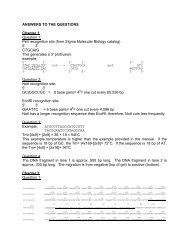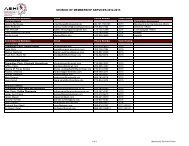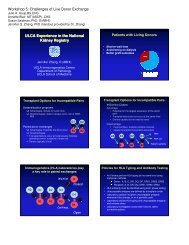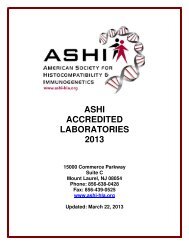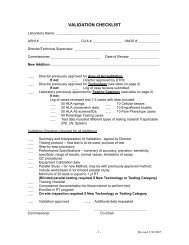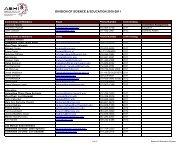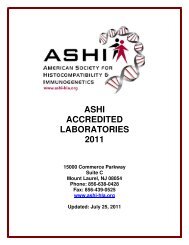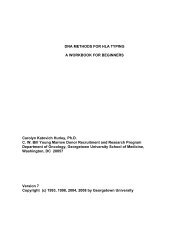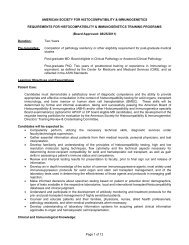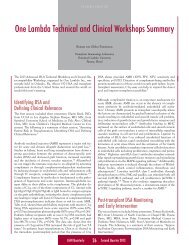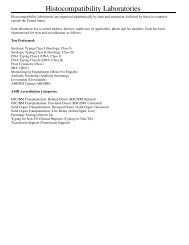7-ORTHE IMPACT OF A POSITIVE ENDOTHELIAL CELL CROSSMATCH (ECXM) IN ANINCOMPATIBLE RENAL TRANSPLANT RECIPIENT.Annette M. Jackson 1 , Robert A. Montgomery 2 , Lorraine C. Racusen 3 , Edward S. Kraus 1 . 1 Medicine, JohnsHopkins University, Baltimore, MD, USA; 2 Surgery, Johns Hopkins University, Baltimore, MD, USA;3 Pathology, Johns Hopkins University, Baltimore, MD, USA.Aim: To investigate the impact of non-HLA antibodies following an ABO and HLA incompatibletransplant (tx).Methods: Flow cytometric crossmatches were per<strong>for</strong>med using donor lymphocytes (FCXM) andendothelial cell precursor cells (ECXM) as targets. ECs were isolated using magnetic beads coated withanti-Tie2 antibodies. Donor specific HLA antibodies (DSA) were detected using solid phaseimmunoassays. Allograft rejection was defined using Banff criteria.Results: A 60 year old male with a cPRA of 55% received a kidney tx via paired kidney donation. Thedonor was ABO incompatible (blood group B to O) but provided a reduced HLA barrier (FCXM+) whencompared to his original donor (CDC+, titer 32). Positive T and B cell FCXMs were consistent with DSAto HLA-A11 and A31.The patient was desensitized using plasmapheresis (PP), low dose IVIg, anti-CD25,and anti-CD20 antibodies. The patient’s anti-B titer fell from 256 to 8 and FCXMs were negative by day oftx. The patient was discharged with a serum creatinine (SCr) of 1.3 mg/dl and an anti-B titer of 4. A biopsy,24 days post-tx, showed 2A cellular rejection with a component of AMR with no rise in DSA or anti-Btiter. Following treatment with a T cell depleting antibody and PP, his SCr returned to baseline. Biopsiesper<strong>for</strong>med at 3 and 4 months post-tx showed persistent AMR with no significant change in DSA or ABOantibodies; the patient was treated with high dose IVIg. ECXM tests were per<strong>for</strong>med and showed a positiveECXM pre-tx in the presence of HLA-A11 and A31 DSA, a negative post-tx ECXM followingdesensitization, and positive ECXMs at 4 and 7 month post-tx (pre and post high dose IVIg treatment).Conclusions: Non-HLA antibodies were detected concomitant with AMR in a patient following anincompatible tx. These antibodies were reduced following PP and low dose IVIg treatments but weobserved no reduction following treatment with high dose IVIg.8-ORARE HLA Cw DONOR SPECIFIC ANTIBODIES AS CLINICALLY SIGNIFICANT IN AMR INRENAL TRANSPLANTATION AS ARE OTHER HLA ANTIBODIES? A CASE STUDY.Luz Stamm 1 , Mauricio Monroy-Cuadros 2 , Kevin McLaughlin 2 , Noureddine Berka 1 . 1 Tissue Typing,Calgary Laboratory Services, Calgary, AB, Canada; 2 Southern Alberta Transplant Program, AlbertaHealth Services, Calgary, AB, Canada.Aim: A 35 year old female with Goodpasture’s disease was worked up <strong>for</strong> an unrelated living donorkidney.[table1]The AHG-CDC crossmatch was negative, Flow T cell crossmatch was positive. SingleAntigen (SA) by Luminex showed antibodies with specificity to Cw antigens with the strongest bead (MFI5<strong>00</strong>0) directed to donor specific antibody (DSA) Cw9 (3).[table2]Methods: Patient received 360 mg of Mycophenolate Acid a week prior to the transplant and was inducedwith 75mg of ATG. A triple therapy immunosuppression was started with FK-506, Mychophenolate acidand steroids.Results: Creatinine level came down and reached her baseline of 85 µmol/L after the first week. The titerand specificity of DSA is being monitored closely in this patient and up to date DSA remain the same asinitially tested.Conclusions: Little in<strong>for</strong>mation can be found in the literature as to the implication and relevance of HLACw donor specific antibodies in the risk of acute antibody mediated rejection in renal transplantation. Inthis unique case, this patient’s antibodies are specific to HLA Cw making it an interesting case <strong>for</strong> followup. Since the cell surface expression of the C locus antigens has been estimated at 10% in relation to A andB antigen, its relevancy in the importance of rejection is not known. Studies have been focusing on theimportance of the HLA epitopes sites to which the antibodies bind. With the development of SAtechnology, the identification of these epitopes has proven very useful. This case may help to prove theclinical importance in the future analysis of HLA Cw antibodies.
<strong>Monday</strong>, <strong>September</strong> <strong>27</strong>, <strong>2010</strong>2:<strong>00</strong> <strong>PM</strong> - 3:30 <strong>PM</strong>Abstract Session 1: New Technologies and Assays9-ORMICROARRAY-BASED HLA TYPING, ON UNPURIFED DNA SAMPLES FROM BLOOD ANDBUCCAL SWABS.Gina Lopez 1 , Andrew Abalos 1 , Kevin Keisler 1 , Melissa May 2 , Rick Eggers 1 , Kevin Obrien 1 , Paul Dunn 3 ,Krishna Jayaraman 1 , Michael Hogan 1 . 1 Research & Development, Genomics USA, Tucson, AZ, USA;2 Arizona Cancer Center, University of Arizona, Tucson, AZ, USA; 3 HLA Laboratory, New Zealand BloodService, Auckland, Epsom, New Zealand.Aim: Current technologies <strong>for</strong> high resolution HLA typing were originally developed to support organ andmarrow transplantation in the clinic, where large amounts of genomic DNA are readily available from avenous blood draw, and where the medical procedure is valuable enough to justify lengthy, relativelyexpensive, sample preparation. However, if HLA typing is to be applied to population-scale screening,sample size and the allowable test cost must be reduced, thereby necessitating a search <strong>for</strong> HLA typingtechnologies that are less expensive and, ideally, per<strong>for</strong>med on unprocessed blood or cheek swabs.Methods: HLA typing of this study was per<strong>for</strong>med on raw venous blood, stored frozen until use, and uponcheek swabs, collected with a cotton swab, stored dry until rehydration and use. The raw samples were thensubmitted to tandem PCR, then microarray analysis on chips specific <strong>for</strong> HLA A, B & DRB21 loci.Results: We present preliminary validation of a low-cost microarray approach to HLA typing, that isoptimized so that testing can be per<strong>for</strong>med directly on a microliter of raw blood or 2 microliters of a raw,rehydrated cheek swab sample without DNA extraction. These data show that, beginning with raw blood orcheek swabs, HLA types are obtained <strong>for</strong> HLA-A, HLA-B and HLA-DRB1 that are identical, withinexperimental accuracy, to those obtained with extracted DNA as the sample input.Conclusions: We demonstrate that HLA-typing can be per<strong>for</strong>med in a relatively simple microarray <strong>for</strong>mat,with little specialized equipment, other than a slide imager, and with no special knowledge of thecomplexity of HLA allele structure, on DNA samples that are equivalent to 1/50th of a drop of blood or1/50th of a raw cheek swab. We propose that because of its technical simplicity and very modest samplerequirements, this simplified HLA microarray technology may enable routine HLA typing as part ofpopulation screening and clinical research.Lopez: Genomics USA: Employee; Stockholder. Abalos: Genomics USA: Employee; Stockholder. Keisler:Genomics USA: Employee; Stockholder. Eggers: Genomics USA: Employee; Stockholder. Obrien:Genomics USA: Employee; Stockholder. Dunn: Genomics USA: Consultant; Science Med Advisor.Jayaraman: Genomics USA: Employee; Stockholder. Hogan: Genomics USA: Employee; Stockholder.10-ORDOUBLE CORD TRANSPLANT SCREENING AND MONITORING ENABLED BY RUOQUANTITATIVE PCR AND CUSTOM SOFTWARE.Douglas A. Bost, Ian J. McLaughlin, Steve Beckert. Celera, Alameda, CA, USA.Aim: STR-PCR is limited in its utility <strong>for</strong> screening and monitoring of donors and recipients in double cordtransplants, given its inherent lack of sensitivity and the presence of stutter artifacts which obscurepotentially in<strong>for</strong>mative alleles. If markers are identified <strong>for</strong> each individual in a double cord transplant, themanual execution of the algorithm <strong>for</strong> quantification of individuals is quite time-consuming. To simplythese analyses, we designed a system of RUO assays and software enabling instantaneous markeridentification and quantification post-PCR.Methods: We employ a panel of 31 quantitative PCR assays to bi-allelic indels in which the probability offinding at least one in<strong>for</strong>mative marker is >99.9% in unrelated individuals (Caucasian, African, Japanese,Amerindian populations). The probability of finding at least one in<strong>for</strong>mative marker in siblings is > 99%,98%, 98% and 97% <strong>for</strong> European Caucasian, Japanese, Amerindian and African populations, respectively.Results: Each assay was tested using simulated DNA mixtures at 0.05%, 0.1%, 0.2% and 0.4% minorcomponent <strong>for</strong> 250 ng of input genomic DNA. Each assay detected the 0.05% minor component mixture.The limitation at this low sensitivity is input copy number. In addition, each of the assays in the panel was
- Page 1 and 2: Monday, September 27, 20102:00 PM -
- Page 3: 5-ORTWO CASES OF DONOR SPECIFIC ANT
- Page 7 and 8: Results: PHA-induced mRNA expressio
- Page 9 and 10: conjugated IgM (BD Biosciences), Ig
- Page 11 and 12: Methods: Peripheral blood and endom
- Page 13 and 14: Aim: NK cells have an established r
- Page 15 and 16: Methods: Sera (n=22) were tested fo
- Page 17 and 18: expression on lymphocytes, we hypot
- Page 19 and 20: Conclusions: Clean SA beads can eli
- Page 21 and 22: goal is to re-examine our previous
- Page 23 and 24: Aim: There is increasing evidence t
- Page 25 and 26: esult in poor graft survival. The g
- Page 27 and 28: Aim: Pronase treatment eliminates i
- Page 29 and 30: 34-PCLINICAL AND PATHOLOGICAL SIGNI
- Page 31 and 32: Nabil Mohsin, Isabelle G. Wood, Ind
- Page 33 and 34: donor/recipient pairs for transplan
- Page 35 and 36: and tested in the DynaChip assay fo
- Page 37 and 38: average difference between Ave and
- Page 39 and 40: Conclusions: The XM-One assay can b
- Page 41 and 42: 59-PCYTOTOXIC AND NON-CYTOTOXIC ANT
- Page 43 and 44: data suggests that DTT pretreatment
- Page 45 and 46: Bhavna Lavingia 1 , Chantale Lacell
- Page 47 and 48: ATG INTERFERNCE IN SINGLE ANTIGEN L
- Page 49 and 50: 75-PPREFORMED LOW REACTIVE ANTI-HLA
- Page 51 and 52: Sabarinathan Ramachandran 1 , Naohi
- Page 53 and 54: 83-PALLELIC DIVERSITY OF KIR2DL4 AN
- Page 55 and 56:
São Paulo, Brazil; 3 Commissariat
- Page 57 and 58:
91-PCHARACTERIZATION OF COMMON AND
- Page 59 and 60:
Conclusions: The extensive diversit
- Page 61 and 62:
99-PPOTENTIAL COMMON NOVEL ALLELES
- Page 63 and 64:
103-PTOWARDS A FUNCTIONAL HLA-DPB1
- Page 65 and 66:
107-PWHOLE GENOME AMPLIFICATION (WG
- Page 67 and 68:
111-PLOSS OF MISMATCHED HLA IN FAMI
- Page 69 and 70:
115-PDONOR EPITHELIAL CELL CHIMERIS
- Page 71 and 72:
Caucasian patients. MRs vary signif
- Page 73 and 74:
Results: We obtained the total No.
- Page 75 and 76:
cord blood and platelet transfusion
- Page 77 and 78:
131-PASSOCIATION OF IL-2-330(G/T) W
- Page 79 and 80:
Institute, Children’s Hospital Oa
- Page 81 and 82:
Methods: To prove the robustness of
- Page 83 and 84:
populations.We studied the involvem
- Page 85 and 86:
amplicons generated from different
- Page 87 and 88:
Results: The sequence of the unexpe
- Page 89 and 90:
concentration of the Taq Polymerase
- Page 91 and 92:
160-PASSOCIATION OF HAPLOTYPES WITH
- Page 93 and 94:
164-PDETECTION OF A DE NOVO DONOR S
- Page 95 and 96:
168-PA NOVEL HLA-DQB1 ALLELE CONFIR
- Page 97 and 98:
172-PSCREENING FOR HLA-SPECIFIC ALL
- Page 99 and 100:
176-PIMPLEMENTATION OF THE WORLD HE
- Page 101 and 102:
epertoire of displayed ligands and
- Page 103 and 104:
mucosa. No other samples were avail
- Page 105 and 106:
Conclusions: In previously reported
- Page 107 and 108:
Conclusions: Our findings can demon
- Page 109 and 110:
Conclusions: In analyzing this data
- Page 111 and 112:
examined on microarrays from a huma
- Page 113 and 114:
Methods: Serial analysis of sera ob
- Page 115 and 116:
Conclusions: These new technologies
- Page 117 and 118:
allograft injury. Four of these 18
- Page 119 and 120:
A NOVEL HLA CLASS I SINGLE ANTIGEN
- Page 121 and 122:
Results: Approximately twice as man
- Page 123:
Methods: Molecular HLA typing was p



